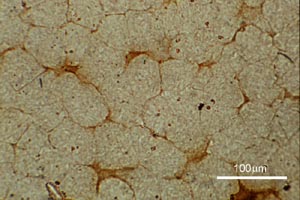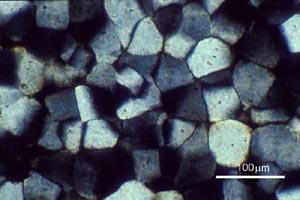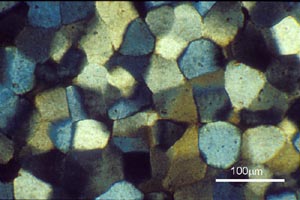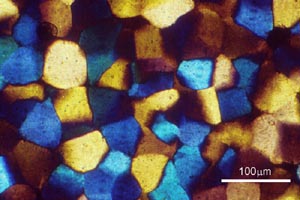10.5: Polarised Light
- Page ID
- 8231
Visible light is a form of electromagnetic radiation, with electric and magnetic vectors oscillating perpendicular to the direction of propagation. Usually the oscillations are in any direction perpendicular to the direction of propagation; polarised light is light with oscillations in a few, restricted, directions.
Polarised light has a variety of uses including in Polaroid sunglasses, which block out light of a certain polarisation, removing much of the glare from the ground. The following flash animation gives an introduction to how polarised light is used in microscopy.
As can be seen, two polarising films at 90° to one another transmit no light; inserting an optically anisotropic material between the polarisers can result in the light vector being rotated.
When light enters an optically anisotropic material, the light vectors are polarised in two Permitted Vibration Directions (PVDs). The difference in refractive index of these directions results in a retardation of one ray with respect to the other; the rays propagate at different speeds within the material and exit with a phase difference between them. This causes one light frequency (i.e. one wavelength) to show destructive interference, and that wavelength of light is lost. Other wavelengths will constructively interfere (to different extents), so different colours are seen, depending on the retardation. This is called birefringence .
A quartz wedge under crossed polars shows how the observed colour changes as the retardation increases. In the photo below, the wedge increases in thickness from left to right. As the thickness increases, the retardation also increases. The quartz wedge below shows a range of birefringent colours as its thickness varies. The relation between retardation, birefringence and thickness can be seen on a Michel-Levy chart.

The retardation also depends on the orientation of the optical axes of the material relative to the polarised light (so rotating the stage may change the colour).
The arrangement of the crossed polars also allows for the insertion of plates at 45° to the planes of polarisation. These are used to enhance the contrast in a specimen. For further effects, it is also often possible to rotate one of the polarisers if crossed polars are not to be used.
When observing a specimen, differences in birefringence allow phases and grains to be identified. For example, different grain orientations may exhibit differences in birefringence and this will cause them to appear a different colour.
The series of photos below shows the difference in the appearance of some glass ceramic specimens as different plates are inserted.
|
|
|
|
Glass ceramic transmission microscope image made with unpolarised light. |
Glass ceramic transmission microscope image made with polarised light. |
|
|
|
|
Glass ceramic transmission microscope image made with polarised light and quarter wave plate. |
Glass ceramic transmission microscope image made with polarised light and full wave plate. |
Optically anisotropic materials aligned with one of the permitted vibration directions parallel to the direction of the polarised light vector appear ‘in extinction’ (i.e. black) between crossed polars.






